Reptiles and Amphibians
Media
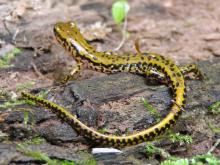
Species Types
Scientific Name
Eurycea longicauda longicauda (eastern dark-sided salamander) and E. l. melanopleura (dark-sided salamander)
Description
The eastern long-tailed salamander and closely related dark-sided salamander are agile and can escape predators by using their tails for quick jumps. They live in the southern and eastern parts of Missouri.
Media
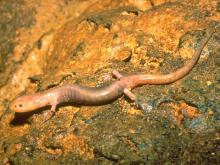
Species Types
Scientific Name
Eurycea spelaea
Description
The grotto salamander is Missouri’s only species of blind salamander. A true troglobite, it lives in total darkness and has small eyes that are completely or partially covered by their pink or beige skin. Occurs in wet caves in the Ozarks.
Media

Species Types
Scientific Name
Plethodon serratus
Description
The southern red-backed salamander is small and slender, with a distinct, narrow, red or orange stripe along the back that has saw-toothed edges. It hides under rocks, mosses, and rotten logs in Ozark forests.
Media

Species Types
Scientific Name
Necturus maculosus maculosus
Description
Mudpuppies are aquatic salamanders that have plumelike external gills throughout their entire lives. They’re found in the southern half and along the eastern edge of Missouri.
Media
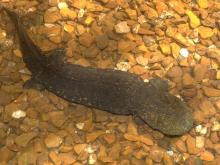
Species Types
Scientific Name
Cryptobranchus alleganiensis alleganiensis
Description
The eastern hellbender is a large, entirely aquatic salamander with a wide, flat head, small, lidless eyes, and soft folds of skin on the sides. In Missouri, it occurs in the northern Ozark highlands in spring-fed rivers that drain north into the Missouri and Meramec river drainages.
Media
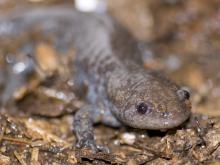
Species Types
Scientific Name
Ambystoma talpoideum
Description
The mole salamander is broad-headed, dull gray or brown, with a small body and tail and large limbs. It spends almost all its time below ground. In Missouri, it is restricted to the lowlands of our southeastern counties.
Media

Species Types
Scientific Name
Ambystoma tigrinum
Description
Tiger salamanders occur statewide. They spend most of their time underground, often in burrows made by small mammals or under logs and rocks. Your best chance of seeing a tiger salamander is at night after a heavy rain.
Media
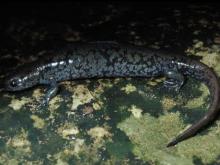
Species Types
Scientific Name
Ambystoma texanum
Description
The small-mouthed salamander is a medium-sized, dark gray to black or dark brown salamander with a small head and mouth. In Missouri, it’s found nearly statewide — but not in the Ozarks.
Media

Species Types
Scientific Name
Eurycea tynerensis (formerly E. multiplicata griseogaster)
Description
The Oklahoma salamander is small, dark, and almost never seen in a fully adult form without gills. Formerly called the gray-bellied salamander, in Missouri, it's found only in the central and southwestern Ozarks.
Media

Species Types
Scientific Name
Cryptobranchus alleganiensis bishopi
Description
The eastern hellbender is a large, entirely aquatic salamander with a wide, flat head, small, lidless eyes, and soft folds of skin on the sides. In Missouri, it occurs only in the southern Ozark Highlands in spring-fed sections of the Black River system and North Fork of the White River system.
See Also
About Reptiles and Amphibians in Missouri
Missouri’s herptiles comprise 43 amphibians and 75 reptiles. Amphibians, including salamanders, toads, and frogs, are vertebrate animals that spend at least part of their life cycle in water. They usually have moist skin, lack scales or claws, and are ectothermal (cold-blooded), so they do not produce their own body heat the way birds and mammals do. Reptiles, including turtles, lizards, and snakes, are also vertebrates, and most are ectothermal, but unlike amphibians, reptiles have dry skin with scales, the ones with legs have claws, and they do not have to live part of their lives in water.





















